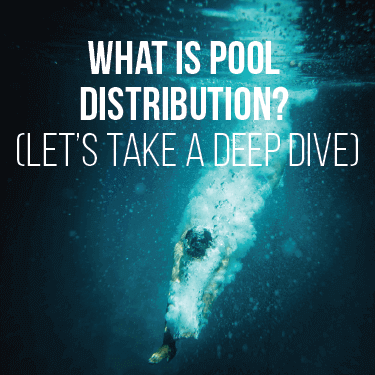
 Copy URL to Clipboard
Copy URL to Clipboard
Optimizing your approach to shipping and distribution is a goal for countless businesses. One of the ways that this can be accomplished is through something called pool distribution. There’s some important questions to ask surrounding pool distribution which include: what is it, how does it work, when should it be used, and more. Before you can answer more detailed questions about pool distribution, you first need to understand what it is.
Pool distribution is a shipping/distribution method in which multiple shipments are combined into one larger shipment. This strategy has a number of similarities to Less Than Truckload (LTL) shipping. However, there’s some key differences that set pool distribution apart and establish itself as its own solution.
There are several unique characteristics that make pool distribution a viable option for many businesses. Before deciding whether or not pool distribution is right for your business, it’s important to have a firm understanding of its purpose, benefits, usage, and more.
Our comprehensive guide below covers everything there is to know about pool distribution.
Table of Contents
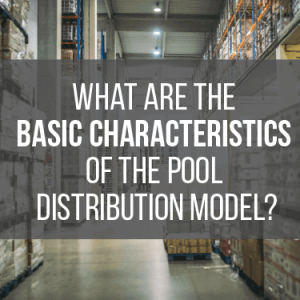
The definition provided above for pool distribution covers the basic concept of it. However, there’s actually a few features and characteristics that combine to create the full model of pool distribution. Each characteristic is unique and plays an important role in the overall process
The main concept at the core of pool distribution is combining multiple, separate shipments into one larger one. This is where pool distribution actually gets its name from; “pooling” multiple shipments together. In some cases, the combined shipments are enough to fill up most of a trailer or the entire space of a trailer. When this occurs, the shipment can be classified as Full Truckload shipping (FTL).
Another characteristic that is present in pool distribution is having access to a regional terminal. Terminals can sometimes be referred to as distribution centers. The pool distribution model only works if a strategically located terminal/distribution center is available.
Once the “pool shipment” has arrived at the terminal, it is unloaded. At this point, the products are then stored at the terminal for delivery at a later time or transferred directly onto another truck for their final delivery. When the goods are taken from an inbound truck and placed directly onto an outbound truck, this is referred to as cross docking.
As mentioned above, local delivery trucks are required to complete the final leg of the shipping journey. These trucks take the individual shipments that were delivered to the terminal and transport them to their final destination.
In some cases, the trucks that transport goods to the distribution center and complete the final delivery are owned by the same carrier. In other situations, different carriers are involved for each step in the journey.

Before determining whether the pool distribution model will work for your business, it’s useful to understand what benefits you can gain.
When using the pool distribution model, you can experience the following benefits:
All of these benefits together create a more efficient and overall improved supply chain. Below, we explore each benefit individually to explain how it occurs and the level of impact you can expect.
While speed isn’t always the number one factor when it comes to shipping, it’s certainly a top priority. With the pool distribution model, quicker shipping times are possible along the initial journey.
After products have been consolidated and picked up by a truck, they then take a direct path to the regional terminal/distribution center. This step differs from the LTL approach in that a truck moving LTL shipments will be making multiple stops along its route, as opposed to just making one stop.
While this doesn’t affect the final leg of the shipment, the improvement can still be drastic over time and with a high frequency of shipments.
Perhaps the only thing better than saving time is saving money. With pool distribution, you can experience both!
Using the pool distribution model can reduce supply chain costs in the following ways:
Curious to know how much you could be saving by using pool distribution? Our fulfillment and logistics experts can help you find out. We’ll thoroughly examine and analyze your current supply chain and distribution program to identify cost savings opportunities.
While shipment tracking isn’t the top priority for all businesses, it’s high on the list for quite a few. Whether you’re up against a tight timeline or tracking a high value, high risk shipment knowing where your shipment is at is important.
With a pooled shipment that makes fewer stops than an LTL delivery, your shipment will be easier to track. Unfortunately, when it comes to LTL shipments there’s no guarantee of how many stops will be made or where they’ll be made. This makes tracking your shipment a bit misleading.
On the other hand, in a pooled distribution shipment, tracking is likely to be consistent and within the parameters of the route. This makes estimating your delivery date much easier and also provides you with a greater peace of mind.
Perhaps one of the biggest downsides of LTL shipping is how often freight in the trailer needs to be rearranged throughout the process of loading and unloading products. Each time a specific pallet of goods need to be rearranged, it’s considered a “touch.” In general, the fewer times freight is touched throughout the shipment, the better.
High-touch freight has some negative consequences including:
With pool distribution, products stay on the truck for a longer period of time and are moved less frequently. This reduces the chances for accidents to occur during the shipping journey.
Similar to improved shipment tracking, this benefit may not be on the top of everyone’s list. However, with the major push to reduce emissions within the trucking industry, many businesses have already begun to adapt.
Generally, the pool distribution model uses fewer trucks than traditional LTL shipments. This is what leads to a reduced carbon footprint.
Many companies now have this goal as part of their company mission. Some states and local governments even offer tax incentives to businesses that commit to and meet certain emission and carbon footprint standards.
No matter which benefits of pool distribution most closely relate to your goals, they’re hard to ignore. If you primarily ship products via LTL, pool distribution should at least be a consideration to explore to potentially realize some of these supply chain improvements.
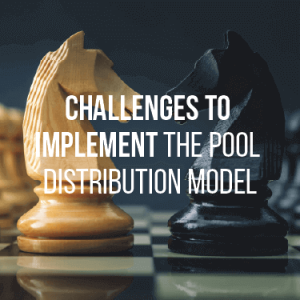
While the benefits of pool distribution are certainly worthwhile, they don’t come without some challenges along the way. Implementing this model of distribution requires you to overcome some minor and potentially major roadblocks. With that being said, they’re far from impossible to deal with, and in most cases, the effort is well worth the effort.
The factors that need to be present in order for pool distribution to work may require quite a few changes to your existing supply chain framework.
Changes that you may need to make include:
These changes are far from impossible to implement. You simply need to be willing to do some additional work upfront to reap the long-term benefits.
Speaking of upfront work, this is one of the biggest changes that you’ll likely need to make. This is one of the toughest challenges in moving from an LTL approach to a pool distribution model. With an LTL model, many shippers simply contact a carrier when they have one to a few pallets of product that need to be moved. This is a spur of the moment type strategy.
Utilizing the pool distribution method, you need to prepare shipments in advance and do so strategically. Taking a measured approach and planning these details ahead of time ensures that you use the most cost effective strategy.
If this task is too difficult for you to tackle on your own, there’s no need to worry. Our fulfillment & logistics experts can help you. We work with companies across a wide range of industries and help them identify supply chain improvements that can be made within their operations.
For the pool distribution model to work properly you’ll need to have the required resources to get the job done. In reality, your logistics partner will be responsible for having these resources; your job is to find the right partner.
If you’re already working with a 3PL or carrier, you can discuss the possibility of moving to a pool distribution model. However, if they can’t meet your needs you’ll need to look elsewhere.
When reaching out to potential logistics partners about utilizing a pool distribution approach, there are some common questions you should be asking. These include:
An experienced and knowledgeable 3PL should be able to confidently answer all of these questions.
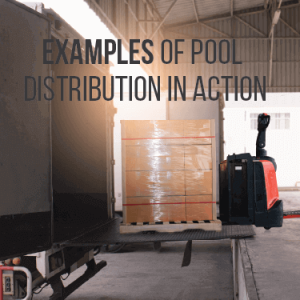
To better understand how pool distribution works, we’ve provided a few helpful examples below:
Example #1
A shipper has 10 pallets of products that are being shipped to 3 different retail locations within a 100 mile radius.
All 10 pallets are placed onto one truck and taken to a regional terminal. The individual pallets are loaded onto separate trucks with each one making a direct route to the 3 retail locations.
Example #2
2 shippers each have 3 pallets of goods going to 2 separate locations within the same city.
All 6 pallets are loaded onto the same truck and delivered to a regional terminal. From there, the pallets are placed onto individual trucks, combined with other shipments going to the 2 locations.
Example #3
Numerous shipments from different origin points are bound for the same end destination.
The buyer of the goods requests that the shipments be sent to a regional terminal near the destination. The separate shipments are then grouped together on one truck and delivered to the destination.
Each of the examples above illustrate situations where fewer trucks are being used and the transportation process is more efficient/
If you’ve come across the term “pool consolidation” in your journey to learn about pool distribution, you might be asking yourself this question. Thankfully, the difference between the two isn’t too difficult to grasp.
Pool distribution refers to the distribution(shipping) portion of the overall journey, while pool consolidation specifically relates to the consolidation(separation & loading) of the product shipment. Pool consolidation is normally just one part of the overall pool distribution model.
In some cases, pool consolidation may be utilized without pool distribution. When this occurs, multiple shipments from one or more shippers share the same space of a truckload, but all go to the same final shipping destination. This is different compared to pool distribution where the shared truckload is separated and distributed to multiple final delivery trucks.
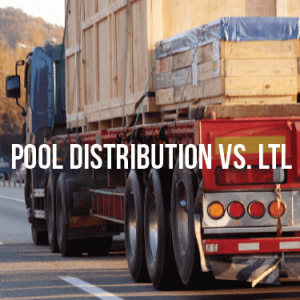
As we noted at the beginning of this article, pool distribution shares a lot of similarities with Less Than Truckload (LTL) shipping. With that being said, there are some key differences between the two that need to be recognized. It’s important to understand what makes these options unique so that you can make the best decision when choosing between the two.
While the benefits of the pool distribution model are outlined above, it’s important to note that it’s not always a viable option. Before deciding to implement this model, there are certain aspects of your distribution and supply chain framework that you need to examine. Once you’ve identified and analyzed the necessary details, then you can make an informed decision.
If the factors below apply to your shipping situation, you should consider utilizing pool distribution
Frequent LTL Shipments to the Same Geographic Region
If this situation applies to your past shipments, you have a prime opportunity to optimize your supply chain with pool distribution. Consolidating multiple LTL shipments into one larger LTL shipment or even an FTL shipment will almost surely reduce your overall costs. This is in addition to shipments often arriving quicker as well.
Flexible Scheduling
Switching to a pool distribution method often requires shippers to adjust their shipping schedules. Having the flexibility to adjust your shipping schedule to accommodate for pool distribution increases the likelihood that you’ll experience success.
A Resourceful & Reliable 3PL/Shipping Partner
Since pool distribution relies heavily on the skills and resources of the companies providing the transportation services, this is a must. Not every 3PL or shipping company will be able to successfully manage your needs using a pool distribution model. Luckily, if you don’t have confidence in your current provider’s ability to meet your pool distribution needs, you can reach out to other companies to find a better partner.
Unlike the above scenarios, if the situations below apply to you, pool distribution might not be your best choice.
Low Order Volume Within a Specific Geographic Region
Pool distribution can only work when there is enough product being delivered to one area to pool multiple shipments together. When there aren’t enough shipments, it simply doesn’t make sense. Trying to delay orders simply to consolidate them with others will lead to more harm than good including frustrated customers or losing suppliers to other companies.
Incompatible Products
Not all products are ideal for pool distribution. Whether products are incompatible with one another or risk spoiling due to being transferred from one truck to the shipping terminal to another truck, this is an important detail that shouldn’t be overlooked. For example, certain fresh food products require specific shipping environments to avoid spoiling. If a shipper has multiple products that require different shipping environments, pooling won’t be possible.
Perishable goods almost always follow the FIFO method of distribution. To learn more, check out our article FIFO Procedures for Warehousing.
Unwillingness To Change
Along with flexible scheduling mentioned above, pool distribution will most likely require you to make some big changes. Whether it’s increasing your ordering volumes, doing additional upfront planning, or switching 3PL’s, change will likely be necessary. If you’re not committed to making the necessary changes to transition to pool distribution, you’ll be destined to fail from the start.
No matter what your distribution and supply chain needs are, we’re prepared to help you. Our team at R+L Global Logistics has the knowledge and experience to use the best solutions for your business. In addition to our knowledge and experience, we have the right resources to get the job done. Our established carrier and distribution network ensure that your shipments will always be in the right place at the right time.
When you’re ready to begin utilizing the pool distribution model or need any other assistance with your supply chain needs, get in touch with our team. Already have a project planned and need a quote? No problem. Request a quote now and our team will provide you with a transparent and hassle-free quote.
